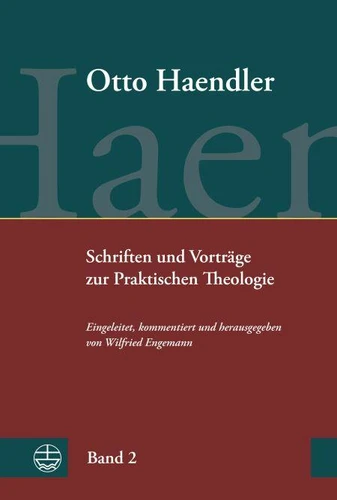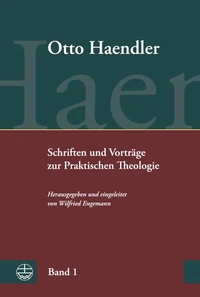Schriften und Vorträge zur Praktischen Theologie (OHPTh). Band 2: Homiletik. Monographien, Aufsätze und Vorträge
Par : ,Formats :
Disponible dans votre compte client Decitre ou Furet du Nord dès validation de votre commande. Le format ePub est :
- Compatible avec une lecture sur My Vivlio (smartphone, tablette, ordinateur)
- Compatible avec une lecture sur liseuses Vivlio
- Pour les liseuses autres que Vivlio, vous devez utiliser le logiciel Adobe Digital Edition. Non compatible avec la lecture sur les liseuses Kindle, Remarkable et Sony
 , qui est-ce ?
, qui est-ce ?Notre partenaire de plateforme de lecture numérique où vous retrouverez l'ensemble de vos ebooks gratuitement
Pour en savoir plus sur nos ebooks, consultez notre aide en ligne ici
- Nombre de pages728
- FormatePub
- ISBN978-3-374-04617-1
- EAN9783374046171
- Date de parution30/11/2017
- Protection num.Digital Watermarking
- Taille2 Mo
- Infos supplémentairesepub
- ÉditeurEvangelische Verlagsanstalt
Résumé
Der Band enthält neben Otto Haendlers berühmter Schrift "Die Predigt" einzelne Beiträge zur homiletischen Theorie, seine Predigtmeditationen und dessen bisher unveröffentlichte Habilitationsschrift zur "Idee der Kirche in der Predigt" (1930). Sie legt dar, warum und wie Pfarrer auf die seinerzeit propagierten gruppen- und massenorientierten Sozialmodelle (Kommunismus, Sozialismus, Nationalismus usw.) reagieren sollten, um "Kirche" als menschliches, Lebensraum bietendes, zukunftsfähiges Gemeinschaftsmodell zur Geltung zu bringen.
Im Fokus seiner Homiletik stehen die konvergenten Prinzipien glaubwürdiger, persönlicher und theologisch stimmiger Predigt sowie eine Freiheit fördernde Glaubenskommunikation. Die Texte werden theologiehistorisch und rezeptionsgeschichtlich eingeleitet und kommentiert. [Publications and Lectures in Practical Theology] This volume includes, besides Haendler's most famous work "Die Predigt" (The Sermon) selected contributions to his theory of homiletics, his homily-meditations and his previously unpublished habilitation thesis "Idee der Kirche in der Predigt" - On the idea of church in preaching (1930).
It states why and how priests should react to, in those days propagandised, group- or mass-oriented social models (such as Communism, Socialism, Nationalism etc.), in order to assert church as a human, living space providing, sustainable community model. His homiletics focuses on the convergent principles of a credible, personally and theologically coherent sermon, as well as on a freedom-promoting communication of faith.
All texts are theological-historically and reception-historically prefaced and annotated.
Im Fokus seiner Homiletik stehen die konvergenten Prinzipien glaubwürdiger, persönlicher und theologisch stimmiger Predigt sowie eine Freiheit fördernde Glaubenskommunikation. Die Texte werden theologiehistorisch und rezeptionsgeschichtlich eingeleitet und kommentiert. [Publications and Lectures in Practical Theology] This volume includes, besides Haendler's most famous work "Die Predigt" (The Sermon) selected contributions to his theory of homiletics, his homily-meditations and his previously unpublished habilitation thesis "Idee der Kirche in der Predigt" - On the idea of church in preaching (1930).
It states why and how priests should react to, in those days propagandised, group- or mass-oriented social models (such as Communism, Socialism, Nationalism etc.), in order to assert church as a human, living space providing, sustainable community model. His homiletics focuses on the convergent principles of a credible, personally and theologically coherent sermon, as well as on a freedom-promoting communication of faith.
All texts are theological-historically and reception-historically prefaced and annotated.
Der Band enthält neben Otto Haendlers berühmter Schrift "Die Predigt" einzelne Beiträge zur homiletischen Theorie, seine Predigtmeditationen und dessen bisher unveröffentlichte Habilitationsschrift zur "Idee der Kirche in der Predigt" (1930). Sie legt dar, warum und wie Pfarrer auf die seinerzeit propagierten gruppen- und massenorientierten Sozialmodelle (Kommunismus, Sozialismus, Nationalismus usw.) reagieren sollten, um "Kirche" als menschliches, Lebensraum bietendes, zukunftsfähiges Gemeinschaftsmodell zur Geltung zu bringen.
Im Fokus seiner Homiletik stehen die konvergenten Prinzipien glaubwürdiger, persönlicher und theologisch stimmiger Predigt sowie eine Freiheit fördernde Glaubenskommunikation. Die Texte werden theologiehistorisch und rezeptionsgeschichtlich eingeleitet und kommentiert. [Publications and Lectures in Practical Theology] This volume includes, besides Haendler's most famous work "Die Predigt" (The Sermon) selected contributions to his theory of homiletics, his homily-meditations and his previously unpublished habilitation thesis "Idee der Kirche in der Predigt" - On the idea of church in preaching (1930).
It states why and how priests should react to, in those days propagandised, group- or mass-oriented social models (such as Communism, Socialism, Nationalism etc.), in order to assert church as a human, living space providing, sustainable community model. His homiletics focuses on the convergent principles of a credible, personally and theologically coherent sermon, as well as on a freedom-promoting communication of faith.
All texts are theological-historically and reception-historically prefaced and annotated.
Im Fokus seiner Homiletik stehen die konvergenten Prinzipien glaubwürdiger, persönlicher und theologisch stimmiger Predigt sowie eine Freiheit fördernde Glaubenskommunikation. Die Texte werden theologiehistorisch und rezeptionsgeschichtlich eingeleitet und kommentiert. [Publications and Lectures in Practical Theology] This volume includes, besides Haendler's most famous work "Die Predigt" (The Sermon) selected contributions to his theory of homiletics, his homily-meditations and his previously unpublished habilitation thesis "Idee der Kirche in der Predigt" - On the idea of church in preaching (1930).
It states why and how priests should react to, in those days propagandised, group- or mass-oriented social models (such as Communism, Socialism, Nationalism etc.), in order to assert church as a human, living space providing, sustainable community model. His homiletics focuses on the convergent principles of a credible, personally and theologically coherent sermon, as well as on a freedom-promoting communication of faith.
All texts are theological-historically and reception-historically prefaced and annotated.





